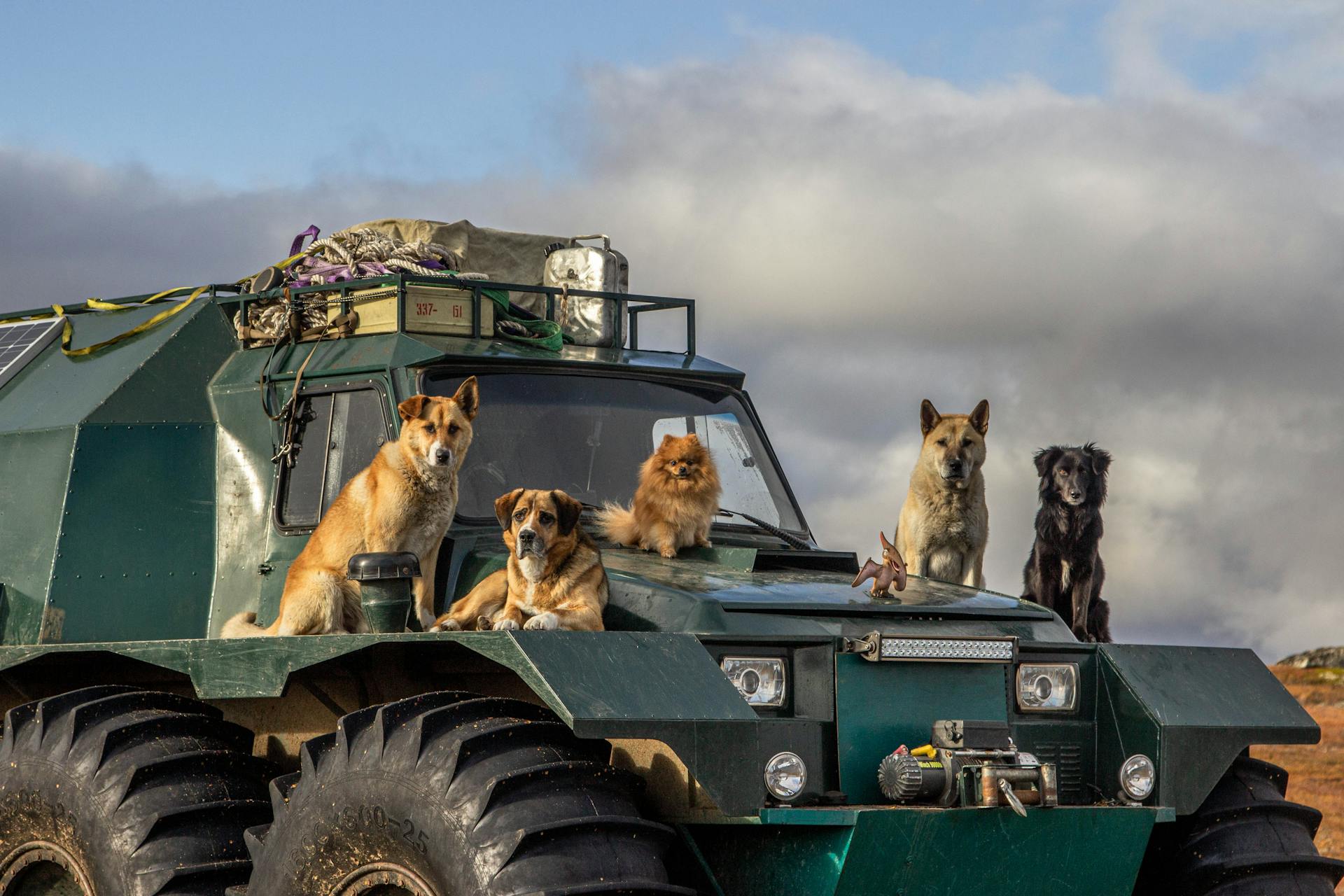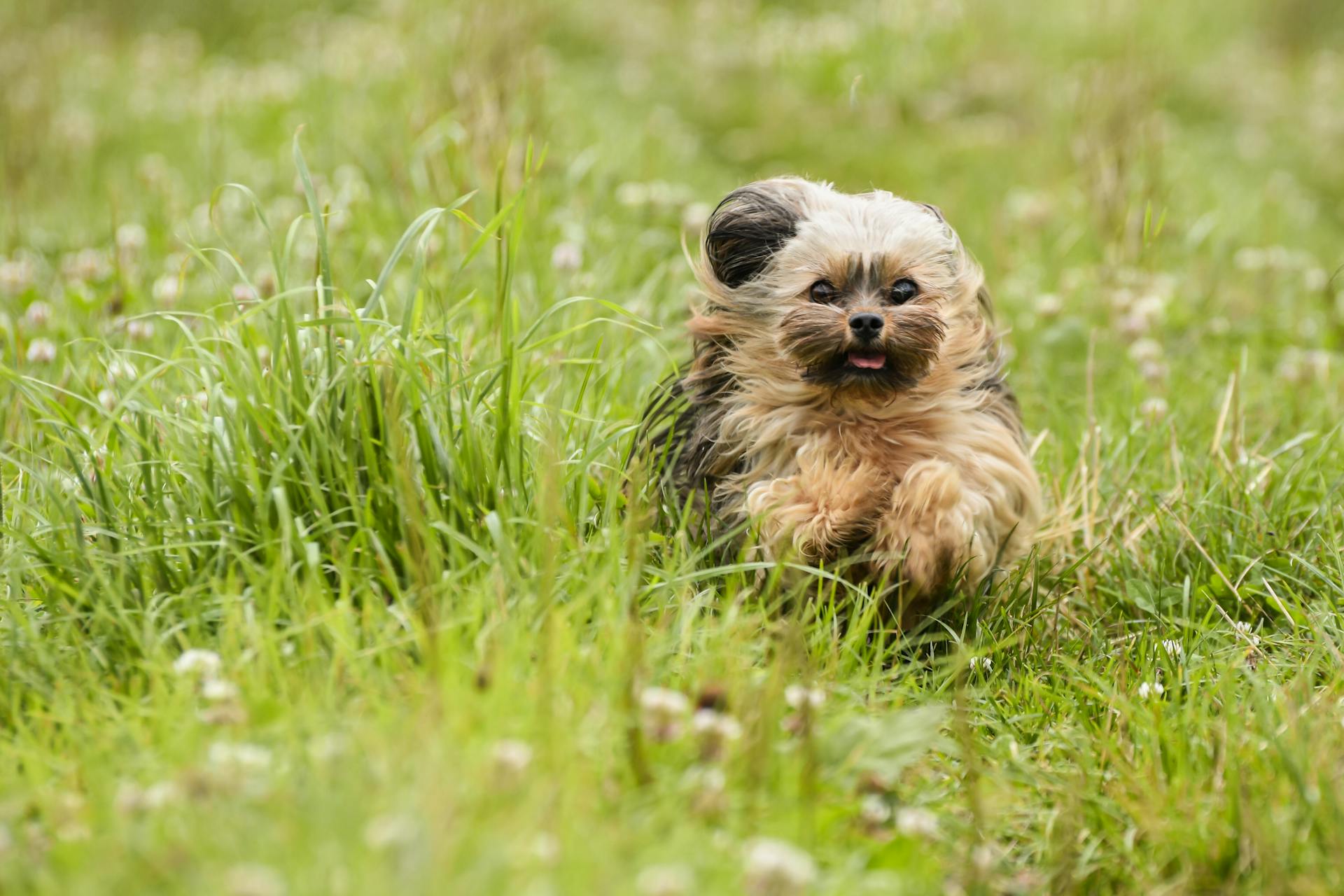
The herding group is made up of breeds that were originally bred to herd livestock, such as sheep, cattle, and horses. These breeds have a strong work ethic and are highly intelligent.
One of the defining characteristics of the herding group is their strong herding instinct, which drives them to gather and control animals. This instinct can sometimes get them into trouble, especially if they're not properly trained or exercised.
Herding breeds are often highly energetic and require regular physical and mental stimulation to prevent boredom and destructive behavior. They need plenty of exercise, training, and attention to keep them happy and healthy.
Some herding breeds, such as Border Collies and Australian Shepherds, are highly trainable and excel in dog sports like agility and obedience.
For your interest: Herding Instinct Test
Herding Breeds
Herding Breeds are known for their intelligence and loyalty. The Belgian Sheepdog, for example, is revered for its intelligence and versatility, making it a valuable asset in various settings.
Some herding breeds require regular exercise to stay mentally and physically fit. The Pembroke Welsh Corgi, despite its small size, needs regular exercise to stay healthy and happy.
Herding breeds are often described as hardworking and diligent. The Border Collie, for instance, is renowned for its herding prowess and unparalleled work ethic.
Belgian Tervuren
The Belgian Tervuren is one of the four Belgian sheepdog breeds/varieties. It's known for its dynamic presence and long, flowing coat.
This breed excels in various roles, from working dog to beloved companion. Its versatility is unmatched, making it a popular choice for many dog owners.
The Belgian Tervuren is a highly intelligent breed, which makes it highly trainable. Its herding instincts are strong, making it well-suited for herding tasks.
As a herder, the Belgian Tervuren is a natural fit for farms and ranches. Its intelligence and trainability make it a valuable asset for any dog owner.
A fresh viewpoint: Northern Breed Group
Bergamasco
The Bergamasco Sheepdog is a distinct heritage breed from the Italian Alps, known for its unique, matted coat.
Originally bred for herding and guarding livestock, the Bergamasco is characterized by its intelligence, loyalty, and steadfast demeanor.
This breed is generally happy with kids and other animals, making it a great addition to families with pets.
The Bergamasco's coat is designed to protect it from harsh mountain weather, which is a testament to its adaptability and resilience.
Worth a look: Bergamasco Sheepdog Puppies
Border
Border Collies are renowned for their herding prowess and unparalleled work ethic.
Originating from the border regions between Scotland and England, this breed has been a diligent worker for generations.
These high-energy pups are super smart and hardworking, making them a great fit for active households.
They can make good family pets, but only if given ample attention and exercise, or they may "herd" small children if not discouraged.
In a highly active household, they'll be plenty happy and extremely affectionate towards their loved ones.
Border Collies are not suited for small city apartments, as they require regular exercise to stay happy and healthy.
You might enjoy: Border Collies Herd Ducks
Pembroke Welsh Corgi
The Pembroke Welsh Corgi is a surprisingly quick and agile dog, despite its short legs. They're originally bred as herders, which means they're naturally inclined to work and stay active.
With a big dog personality in their small dog bodies, Pembroke Welsh Corgis are incredibly affectionate to their people. They're good with other pets and intelligent, but they do require regular exercise to stay mentally and physically fit.
These dogs may look like they'd rather snooze on the couch, but trust me, they need that exercise to thrive.
Shetland
The Shetland Sheepdog is a great breed for apartment dwellers, weighing in at just 20 pounds at most and requiring regular walks or exercise in a fenced-in yard.
They're also sweet, playful, and eager to please, making them excellent companions for families.
Shelties are known for their innate wariness of strangers, making them excellent watchdogs.
As a breed, they're highly trainable and thrive on attention from their owners.
Their small size and adaptable nature make them a great fit for city living or small homes.
Readers also liked: All Herding Breed Dog Rescue
Polish Lowland
The Polish Lowland Sheepdog is a breed that may have roots dating back to the last days of the Roman Empire, in the region that would later become Poland.
They're known for their guard dog capabilities, but also make great companions, which is why residents of Polish cities cherish them.
These dogs require lots of exercise, so be prepared to get moving with your new furry friend.
Their hairiness means they need frequent brushing sessions to stay comfortable and happy.
A Polish Lowland Sheepdog will be a good-natured and obedient companion, making them a great addition to any family.
See what others are reading: Polish Tatra Shepherd Dog
Herding Group
The Herding Group is a fascinating category of dog breeds, known for their intelligence, agility, and strong work ethic. These dogs were originally developed to herd livestock, and many still excel in this role today.
Some popular breeds within the Herding Group include the Australian Cattle Dog and the Australian Shepherd. The Australian Cattle Dog is a robust breed that excels at herding cattle across long distances, while the Australian Shepherd is a versatile breed that can adapt to a variety of tasks.
On a similar theme: Australian Cattle Dog Herding Dogs
Herding dogs are highly trainable and respond well to specific commands. For example, basic herding dog commands include "Come by" or "Just by", which means to go to the left of the stock, and "Away to me" or "Just away", which means to go to the right of the stock. These commands can be indicated by a hand movement, whistle, or voice.
Here are some common herding dog commands:
- Come by or just by - go to the left of the stock, or clockwise around them.
- Away to me, or just away or way - go to the right of the stock, or counterclockwise around them.
- Stand - stop, although when said gently may also mean just to slow down.
- Wait, (lie) down or sit or stay - stop, but remain with that contact on the stock...don't take it off by leaving.
- Steady or take time - slow down.
- Cast - gather the stock into a group. Good working dogs will cast over a large area. This is not a command but an attribute.
- Find - search for stock. A good dog will hold the stock until the shepherd arrives. Some will bark when the stock have been located.
- Get out or back - move away from the stock. Used when the dog is working too close to the stock, potentially causing the stock stress. Occasionally used as a reprimand.
- Keep away or keep - Used by some handlers as a direction and a distance from the sheep.
- Hold - keep stock where they are.
- Bark or speak up - bark at stock. Useful when more force is needed, and usually not essential for working cattle and sheep.
- Look back - return for a missed animal. Also used after a shed is completed and rejoined the flock or packet of sheep.
- In here or here - go through a gap in the flock. Used when separating stock.
- Walk up, walk on or just walk - move in closer to the stock.
- That'll do - stop working and return to handler.
Australian Cattle Dog
The Australian Cattle Dog is a robust and agile breed renowned for its herding prowess. Originally developed in Australia for driving cattle across long distances and rugged terrain, this breed is a perfect fusion of stamina, intelligence, and resilience.
They are bred to withstand a hostile landscape and are about as rough and tumble as they look. Alert, reliable, and tenacious, they were bred to help drive beef cattle across thousands of square miles of Outback territory.
You'll know they're working hard because they nip at the cattle's feet to move them along. This is why they're also called heelers.
Australian Cattle Dogs are compact but muscular, making them well-suited for their rugged work. They can't abide apartment living or other dogs, but put them in the country and give them something to do, and you'll have a great companion for life.
Explore further: Australian Herding Breeds
Australian Shepherd
The Australian Shepherd, frequently referred to as the "Aussie", has a name that might suggest an Australian origin, but it was actually primarily developed in the United States. This breed is renowned for its vibrant appearance, keen intelligence, and boundless energy.
Recognized as a versatile herding dog, the Aussie excels in various roles, from that of a working dog to a beloved companion. They are known for their intelligence and energy, making them a great fit for active families.
The Aussie's versatility is one of its greatest strengths, and they can thrive in a variety of living situations, from apartments to homes with large yards. However, they do require regular exercise and mental stimulation to prevent boredom and destructive behavior.
Here are some key characteristics of the Australian Shepherd breed:
- Herding Dog Sport
- Vibrant appearance
- Keen intelligence
- Boundless energy
Frequently Asked Questions
What is a herding breed personality?
Herding breeds are known for being intelligent, energetic, and loyal dogs that require regular exercise and mental stimulation. They thrive on daily physical and mental activity to stay happy and healthy.
Featured Images: pexels.com


